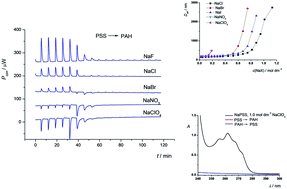Complexation between polyallylammonium cations and polystyrenesulfonate anions: the effect of ionic strength and the electrolyte type†
Abstract
Complexation between polyallylammonium cations and polystyrenesulfonate anions was investigated in aqueous solutions of binary 1 : 1 sodium electrolytes (NaX, X = F, Cl, Br, I, NO3, ClO4) by means of microcalorimetry, dynamic light scattering, electrokinetics and spectrophotometry. At lower molar ratios of monomer units charged polyelectrolyte complexes were formed. At molar ratios close to equivalence and at lower salt concentrations (c(NAX)/mol dm−3 ≤ 0.1) flocculation occurred. The obtained precipitates contained approximately equimolar amounts of oppositely charged monomer units. At c(NAX)/mol dm−3 ≥ 0.5 (X = NO3, ClO4) and in the case when the polycation was present in excess, the amount of positively charged monomer units in the precipitate was higher than that of negatively charged monomers (asymmetric neutralisation). In addition, the aggregation of positively charged complexes in concentrated solutions of all investigated electrolytes was noticed. The onset of aggregation was strongly anion specific. However, the aggregation of negatively charged complexes did not occur even at c(NaX) = 3 mol dm−3. The composition of the insoluble products at equimolar ratio of monomer units and higher concentrations of NaNO3 and NaClO4 was dependent on the order of addition, indicating non-equilibrium interpolyelectrolyte neutralisation under all ionic conditions. At 25 °C and c(NaClO4) = 1 mol dm−3 equilibrium was not reached after two months. In contrast, the supernatants showed no traces of free polyanion chains after being heated for a week at 60 °C. The pairing of monomer units was predominantly entropically driven, irrespective of the type of reaction products formed (polyelectrolyte complexes, precipitates) and the electrolyte type. The results obtained indicate that the overcharging is not an enthalpically demanding process. The calorimetric measurements also suggest that the strong influence of counteranions on the composition of the reaction product must be related to differences in ion distribution around polycations. However, despite rather similar energetics for complex and precipitate formation in the presence of various sodium salts a clear correlation of formation enthalpies with corresponding anion hydration enthalpies (Hofmeister series) was observed. Somewhat surprisingly, the titration calorimetry experiments have also revealed that the increase in electrolyte concentration affects the enthalpy of interpolyelectrolyte neutralisation negligibly.


 Please wait while we load your content...
Please wait while we load your content...